Xinjiang is a Good Place! Northwestern China’s Xinjiang is the largest provincial region of China with nearly a sixth of the total land area of the country. It has up to 1,100 tourist attractions of different types, including magnificent mountains, beautiful lakes, vast grasslands, unique landform (Danxia, Yardang...), grand canyons, primitive forests, wild deserts, rich flora and fauna, sweet fruits, etc., ranking the top in China. Besides, in ancient times, Xinjiang was the Western Region on the Silk Road, where the old China made economic and cultural contact with the world. Thankfully, Xinjiang has well kept the cultural diversity of different minorities, particularly the multi-ethnic groups’ different religions, skills, art, literature, architectures, languages, festivals, dining & dress culture and customs. Plenty of historical and cultural sites have also been left to help people explore the previous splendor of Xinjiang, covering ancient cities, tombs, grottoes, bazaars, mosques, museums, ethnic villages and so forth.
What’s the top attraction to visit for travelers to Xinjiang? What are the best things to do? What are the points of interest most recommended for first-timers? The answers vary from tourist to tourist. To help you find inspiration for your trip to Xinjiang, below we list some of the most worth-seeing tourist attractions covering both natural and cultural highlights in Xinjiang.
Table of Contents
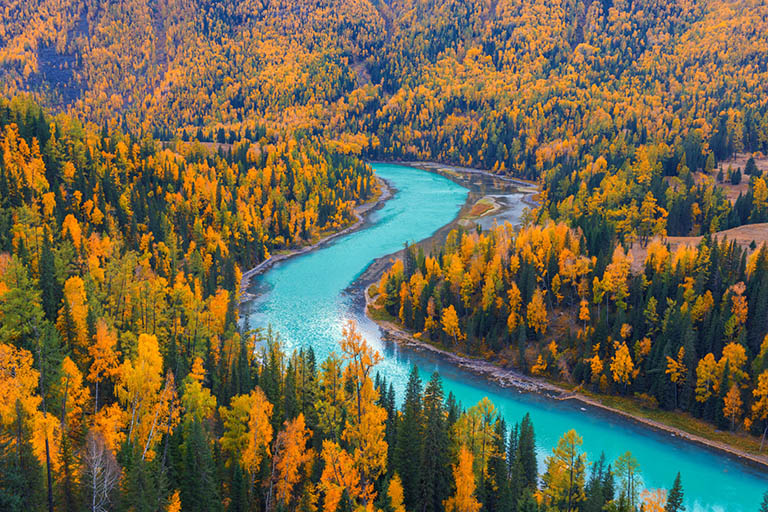
Kanas Lake ©GOOM果果 / mafengwo
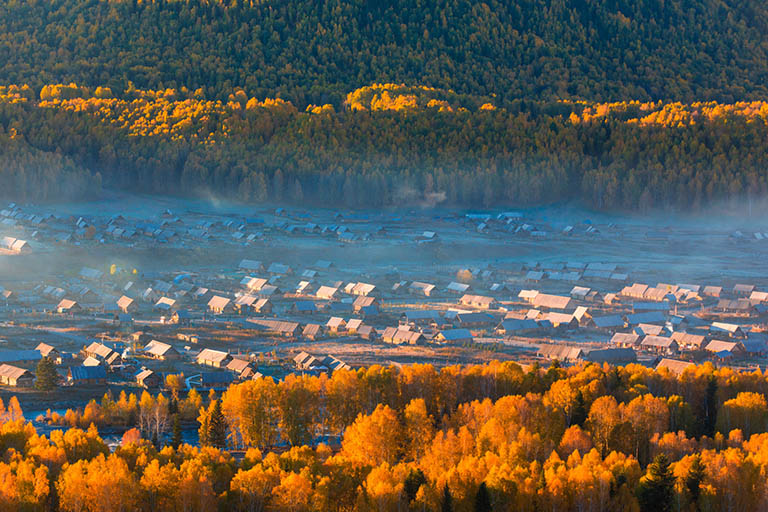
Hemu Village ©GOOM果果 / mafengwo
• Location: Burqin County, Altay Prefecture, Xinjiang
• Best Time to Visit: May ~ Early & Mid-September
• Recommended Visiting Time: 2 ~ 3 days
Kanas means beautiful and mysterious lake in Mongolian. Kanas Scenic Area is one of the top-rated attractions in Xinjiang and a fabulous must-visit natural sight. Situated in the middle of the Altai Mountains, the north of Buriqn County, Altay, Northern Xinjiang, Kanas is a national geopark, forest park, nature reserve and natural heritage. Stunning natural beauty has won Kanas the title of “the Private Garden of Gods”, because primitive high mountains, gorgeous lakes, bays, beaches, woods, meadows and authentic nomadic traditions exist purely. It is a great place for summer resort, leisure sightseeing, nature encounters and photography.
The most attractive spot is the crescent Kanas Lake fed by melt runoff of glaciers and rainfall. The lake is the deepest alpine freshwater lake in China. Its lake water presents different colors when weather and season change, such as turquoise and sapphire. Walking along the wooden paths, you can visit the famous three bays - Wolong Bay with a dragon-shaped islet surrounded by jade water, iconic Moon Bay where the blue water turns an aesthetic “S” and Fairy Bay where morning mist makes a dreamlike fairyland. Virgin forests and grasslands on shore greatly expand their natural beauty. Taiga Forest Corridor is a quieter trial to savor the fresh air in dense forests. Climbing up to Guanyu Pavilion with 1,068 steps, the reward is the amazing panoramic view of Kanas Lake, surrounding forests and majestic snowy mountains in the distance. Enjoying an amazing sea of clouds needs some luck. Hemu Village near Kanas Lake is the largest Tuva village among the three last remaining. Rows of little wooden houses, large Birch trees, imposing mountains and grassland around let your time slow down here. You can stay overnight in a timber house, shoot morning mist, visit a local Tuva family, ride a horse, make a hiking trip or experience winter snow fun in Hemu Village. The village and lake in summer show refreshing green and autumn makes them ravashing fairylands.
Most Recommended Kanas & Hemu Village Tours:
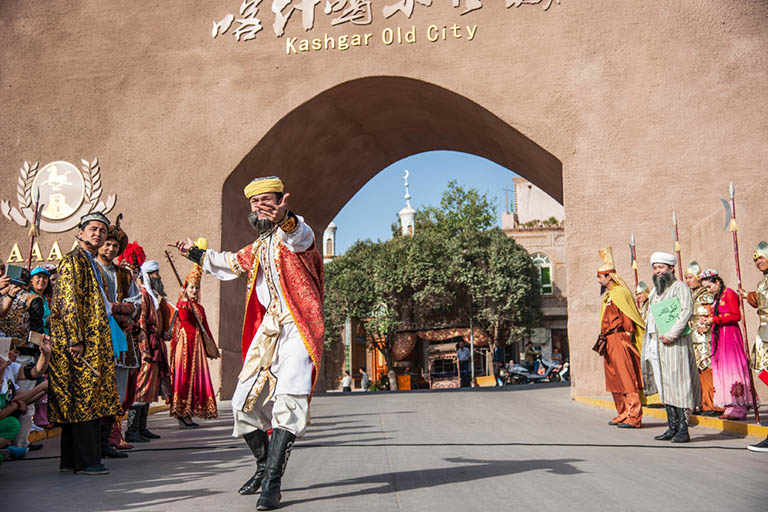
Kashgar Old Town ©骆小洛的世界 / mafengwo
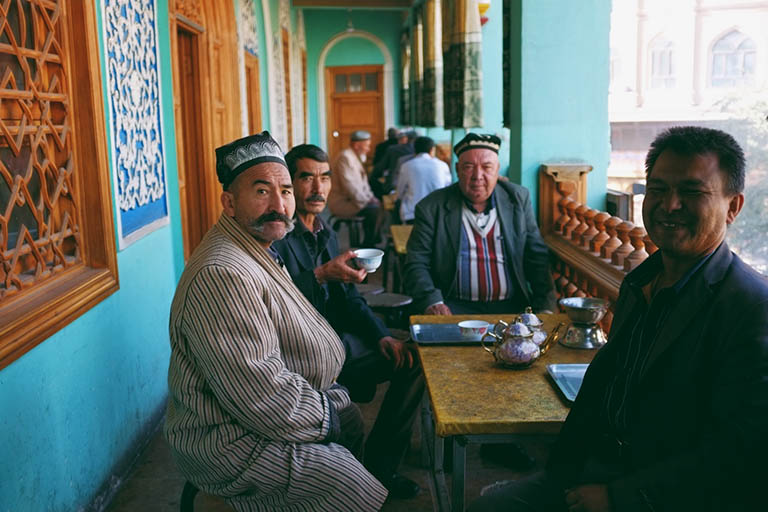
Kashgar Century-Old Teahouse ©真真 / mafengwo
• Location: Kashgar City, Kashagr Prefecture, Xinjiang
• Best Time to Visit: All year round, especially August to October
• Recommended Visiting Time: 1 day
Kashgar is the best place to explore the culture and history of Xinjiang and Kashgar Old Town (or called Kashgar Ancient City) in central Kashgar is the heart of Kashgar. The old town has a long history of 2,000 years, most noted as a living exhibition of Xinjiang Uygur’s daily life and folk customs and the only maze-like city community featuring Islamic culture. Kashgar Old Town is also the setting of the famous movie - The Kite Runner. Streets and alleys crisscross the town with century-old traditional residences standing on both sides. The streets follow old names of the Uygur language and all have special meanings. The dwelling house complex in Kashgar Old Town is one of the world’s largest earth constructions and local people still live there.
Apart from walking through the lanes, you can visit the Kashgar Century-old Teahouse, witness daily routine and enjoy local-style leisure time, visit layered Gaotai ancient homes, taste various snacks and fruits and explore different shops whose owners inherit traditional craftsmanship. The best part is to record the lovely faces of local people, share with their happiness and innocence. With a few more days, it’s very popular and recommended to extend trip to Tashkurgan and view breathtaking scenery of Karakul Lake & Muztagh Ata on Pamirs Plateau.
Recommended Kashgar Tours with Kashgar Old Town:
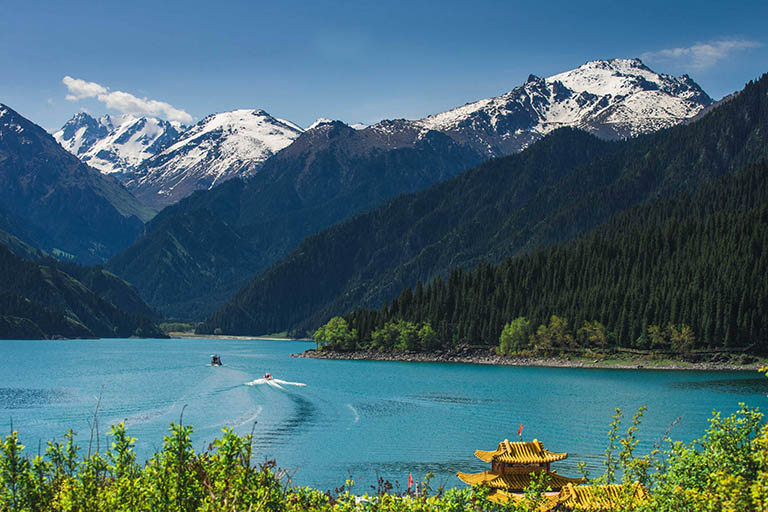
Heavenly Lake of Tianshan Mountains ©泽熙seacen / mafengwo
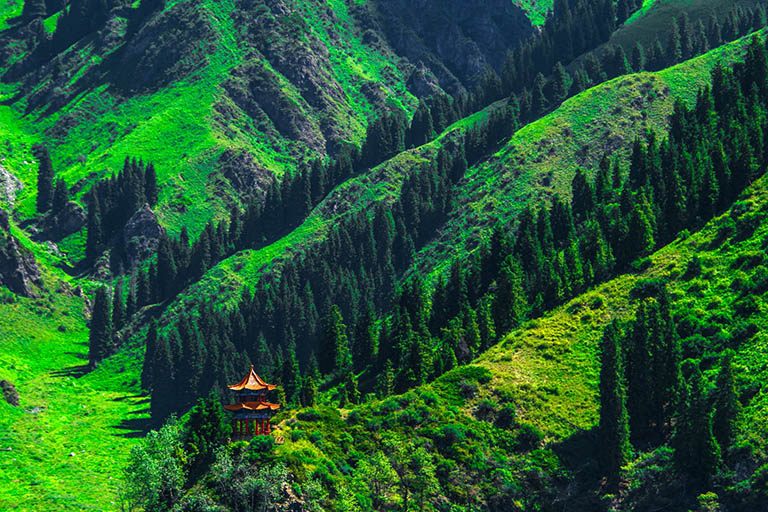
Primitive Forests around Heavenly Lake of Tianshan Mountain ©陈巍伟 / mafengwo
• Location: Fukang City, Changji Hui Autonomous Prefecture, Xinjiang
• Best Time to Visit: May ~ October
• Recommended Visiting Time: 0.5 ~ 1 day
Situated halfway up the Bogda Peak of Tianshan Mountain, the Heavenly Lake of Tianshan Mountains (Tianshan Tianchi in Chinese) is a hot spot in Xinjiang, a national AAAAA scenic area and a UNESCO World Natural Heritage site. The Heavenly Lake, formally known as “Jade Pool” of Queen Mother of the West in Chinese mythology, looks like a big jewel inlaid in the Tianshan Mountains. The attraction is just about 68 km, 1 hour's drive from Urumqi.
Among the eight scenic zones inside, the cerulean Heavenly Lake is the most eye-catching and beautiful. The lake is half-moon-shaped, embraced by old-aged Picea schrenkiana and wild plants. The fascinating scenery of the peaceful Heavenly Lake with wonderful reflection of surrounding lush forests and far-away snow-topped Bogda Peak will always blow your mind. You can walk around the lake, breathe fresh air and see dense forests ashore, take some great photos, or take a cruise ride above the lake, or take a cable car to view a full view from Mount Maya. There are other small spots you can explore, such as little lakes, waterfalls, mountains, Kazak Folklore Garden and some Taoist temples and palaces.
Recommended Heavenly Lake of Tianshan Mountain Tours:
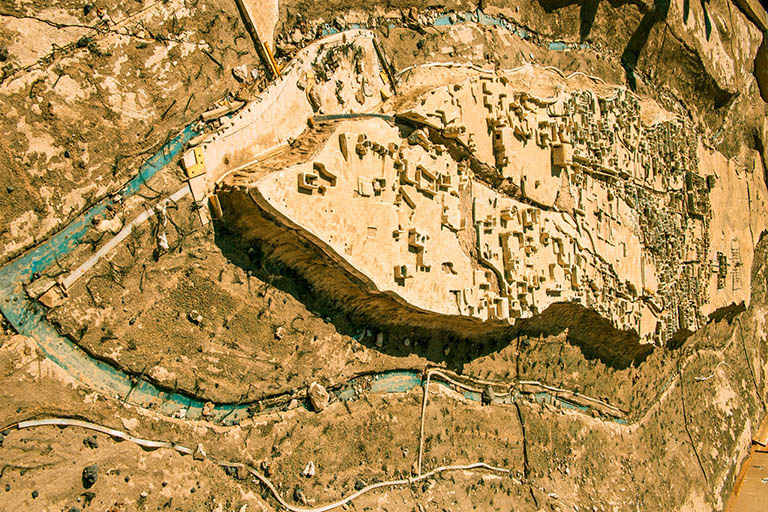
Jiaohe Ancient City ©陈巍伟 / mafengwo
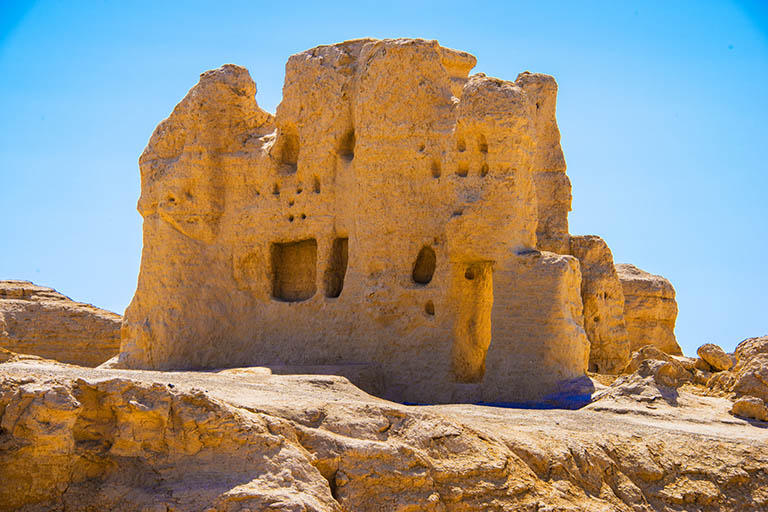
Jiaohe Ancient City ©陈巍伟 / mafengwo
• Location: Gaochang District, Turpan City, Xinjiang
• Best Time to Visit: May ~ October
• Recommended Visiting Time: 2 hours
Jiaohe Ancient City in Turpan western suburbs is a historical ruin which is part of the UNESCO World Cultural Heritage site of Silk Roads: the Routes Network of Chang'an-Tianshan. Named after two rivers converge, this site has a leaf shape with a large scale of clay architecture. Jiaohe Ancient City is renowned as the most complete city ruins in China and the biggest, oldest and best-preserved earth constructed city, and "the most perfect ruin of earth building" in the world.
Jiaohe Ancient City was originally built as the capital of the Cheshi Kingdom by the Cheshi people about 2,500 years ago. Later in the Han and the Tang Dynasties, the city was an important military stronghold. With years of wars, the site gradually declined. Owing to the dry climate and little rainfall in Turpan Basin, most parts have been preserved. Now visitors can see lots of rammed earth buildings in this fortress, small but complete, whose layout is similar to the Chang’an City of ancient Tang Dynasty. Markets, government offices, Buddhist temples, stupa, streets, workshops, residences, drilling ground, trenches and other functional zones can still be found. Many cultural relics have been unearthed, such as the tomb of nobility of Cheshi Kingdom, lotus eaves tile of Tang Dynasty, Buddha Sarira. The entire city is more like a huge ancient sculpture, manifesting a unique architectural style, great wisdom and creativity of ancient Chinese.
Recommended Turpan Tours with Jiaohe Ancient City:
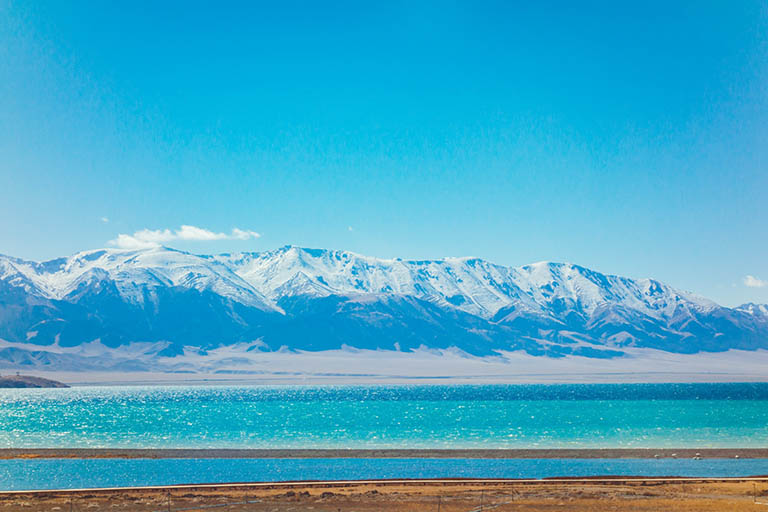
Sayram Lake ©阿拉斯古 / mafengwo
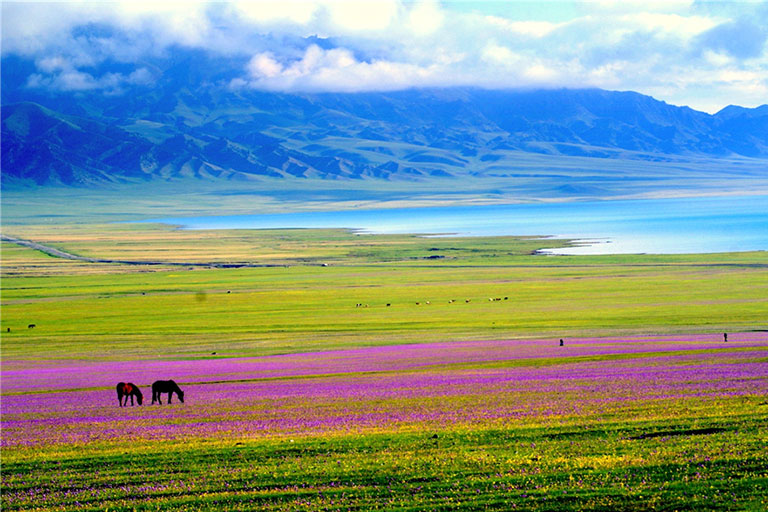
Xihai Grassland by Sayram Lake ©slmhjq
• Location: Bole City, Bortala Mongol Autonomous Prefecture, Xinjiang
• Best Time to Visit: May ~ Early October
• Recommended Visiting Time: 0.5~1 Day
Sayram Lake or Sailimu Lake in Ili Basin, west of Tianshan Mountains, is praised as “the Last Tear of the Atlantic”, because it’s the last place where the warm and moist Altantic current can reach after travelling 7,000 km. With an elevation of 2,000 meters and 450-square-kilometer acreage, Sayram Lake is the highest and largest alpine coldwater lake in Xinjiang. The lake lies about 90 km from Bole City and the G30 National Highway rightly passes through it.
The water of Sayram Lake is blue as the sky, visible and clean as glass, very like a big blue gem embedded in the Tianshan Mountains. The lakeside are boundless grasslands with pretty wild flowers, leisurely grazing horses and scattered yurts. Snow-capped peaks and luxuriant forests a little farther, enormous white floating clouds with the gem-like lake draw an appealing pastoral landscape. Taking an environment-friendly sightseeing car is the most relaxing and popular way to explore the beauty and pureness of Sayram Lake. If fitness permits, you can try a biking trip or even the annual Sayram Lake Cycling Race to create a once-in-a-lifetime experience.
Recommended Sayram Lake Tours:
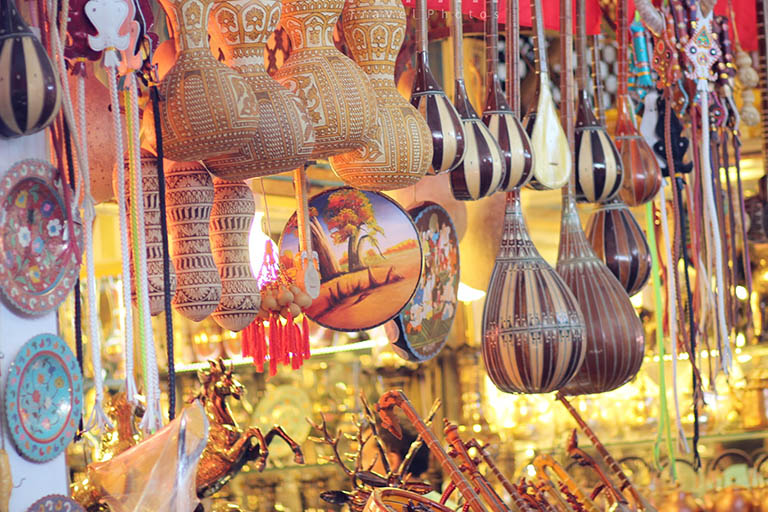
Kashgar Bazaar ©米饭 / mafengwo
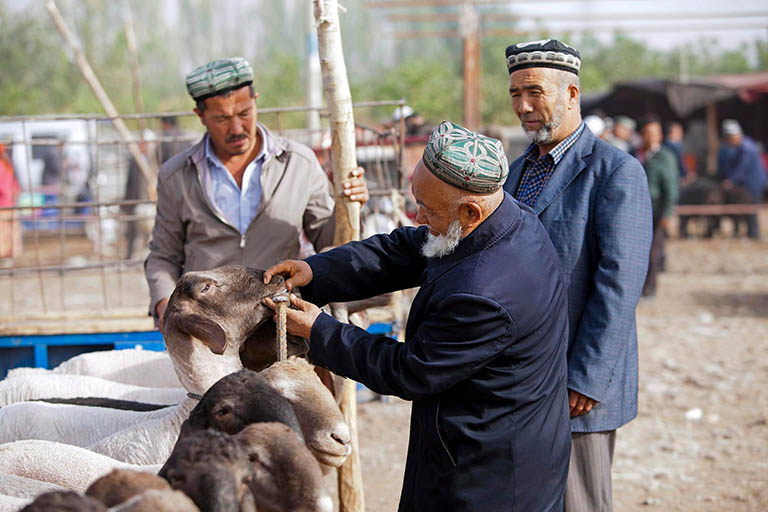
Kashgar Livestock Market ©legolong / mafengwo
• Location: Kashgar, Xinjiang
• Best Time to Visit: May ~ October
• Recommended Visiting Time: 2 hours
Bazaar refers to the market in Uygur language and it commonly exists all over Xinjiang. Compared to the touristy Xinjiang International Grand Bazaar, Kashgar Bazaar is more recommended for an authentic display of the local market atmosphere. Kashagr Bazaar, namely Kashgar Western & Central Asia Bazaar for International Trade, is the biggest international trade market in Northwest China with a long history of more than 2,000 years. There are more than 5,000 shops and stalls selling various Xinjiang products and specialties, ranging from dried fruits, nuts, snacks, to local clothes, hats, musical instruments, handicrafts, etc. You can roam around the bazzar, buy souvenirs and try some local snacks.
Kashgar Livestock Market, the biggest livestock trading market in Xinjiang, is one of the must check out places in Xinjiang. It opens every Sunday only and mainly trades cattle, lambs, horses, donkeys and camels. In the early morning, the livestock will be arranged into rows for buyers to pick. The distinguished feature of this market is the traditional way of trade: an old Uygur man opens the livestock’s mouth and takes a closer look, touches its butt, and then lifts up, hugs it and weighs in hands, bargains, clinches a deal and finally shakes hands with the owner. Apart from watching the busy trades, you can also taste delicious dishes and snacks around the market and shoot some nice pictures of lovely people and trading scenes.
Recommended Kashgar Tour with Bazaar Visits:
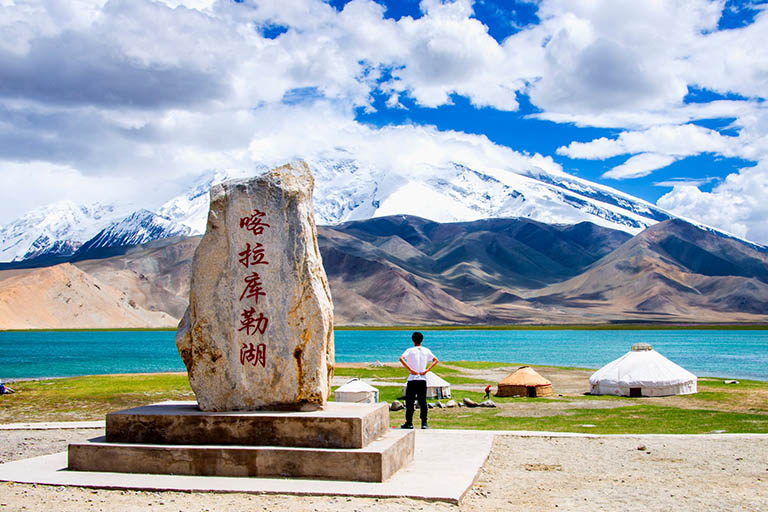
Karakul Lake & Muztagh Ata ©陈巍伟 / mafengwo
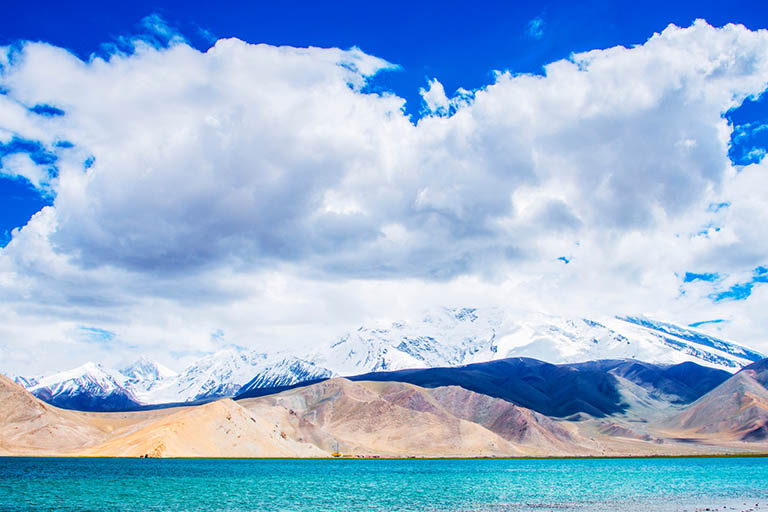
Karakul Lake & Muztagh Ata ©陈巍伟 / mafengwo
• Location: Akto County, Kizilsu Kyrgyz Autonomous Prefecture, Xinjiang
• Best Time to Visit: May ~ September
• Recommended Visiting Time: 1 day
When driving from Kashgar to Tashkurgan along the Karakoram Highway (China-Pakistan Friendship Highway), Karakul Lake and Muztagh Ata are superb awesome landscapes on Pamirs Plateau. Karakul Lake (elevation: 3,600m) is about 190 km/4 hours’ drive from Kashgar Old Town. As an alpine glacial moraine lake, it quietly sits at the foot of the Muztagh Ata (elevation: 7,546m) - the famous “Father of Ice Mountains”. On a good day, the mirror-like Karakul Lake can have unreal reflection of inverted glaciers of grandiose Muztagh Ata and nearby Kongur Tagh (7649 m) and Kongur Tiube (7530 m) - three symbols of Pamirs, which all are snow-covered throughout the year. During the stopover, you can walk around to have a rest, take the chance to record the fine view and try horse riding by the lake. The best seasons to visit Karakul Lake are Summer and Autumn, when the temperature is moderate, the scenery is the most beautiful and there are more sunny days.
Recommended Kashgar Tours with Karakul Lake & Muztagh Ata:
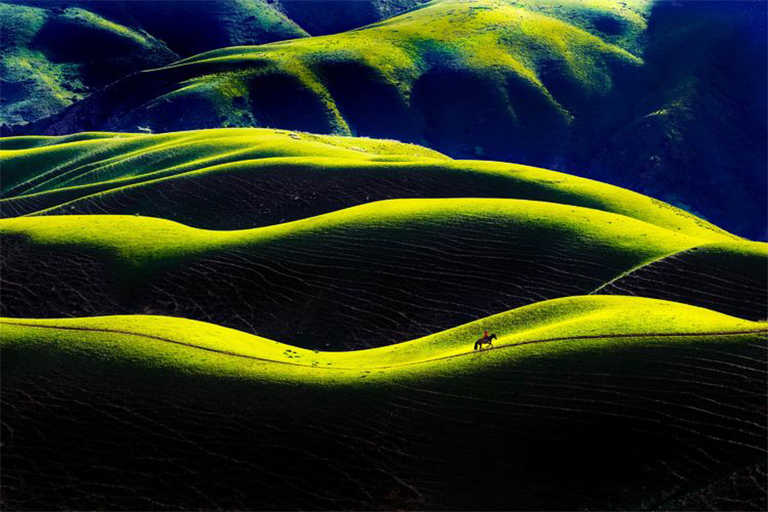
Karajun Grassland ©雨中筑梦 / meipian
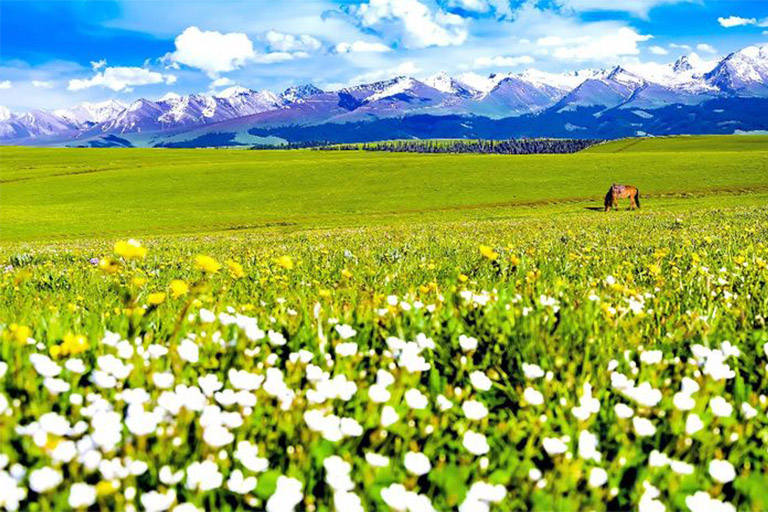
Flower Terrace ©梁柏祥 / meipian
• Location: Tekes County, Ili Kazakh Autonomous Prefecture, Xinjiang
• Best Time to Visit: May ~ September
• Recommended Visiting Time: 1 ~ 2 days
The most beautiful grasslands of Xinjiang are in Ili and Karajun Grassland is one of the famous and best representatives of Xinjiang’s unique three-dimensional grasslands. Karajun (Kalajun) means black vast grassland in Kazak. The place was the capital of Wusun Kingdom - the biggest nomadic ethnic regime in the Western Regions (ancient Xinjiang), the largest racecourse in ancient times and rightly on the northern route of the ancient Silk Road. Today, Karajun has the best showcase of Tianshan Mountains’ alpine meadow steppe with the richest biodiversity and highest aesthetic value and serves as the summer pasture of Kazakh nomads.
Karajun Mountain is an east-west mountain ridge whose two sides are ravines and rolling mountains covered by dense primitive spruce forests. With majestic snow-capped mountains at the back, huge seas of wild woods and flowers in arms, Karajun Grassland presents a scenic stereoscopic grassland view, that you can never feel when viewing the plain grasslands in Inner Mongolia. No wonder it’s a fascinating place for photography and hiking.
Karajun Grassland is comprised of 5 scenic areas and East, West Karajun Grasslands and Kuokesu Grand Canyon are the main places to go for travelers. Sightseeing buses will help you transfer among different scenic areas. East Karajun Grasaland is the core area where you can admire grassland full of pretty wild flowers at Flower Terrace during May and June, appreciate a fantastic panoramic view from Falcom Terrace and see the hilly grassland in Dielang Valley. In Kuokesu Valley, Crocodile Bay has a vivid shape of crocodile head and the spot is a must-visit for photographers wishing to shoot the “Human Body Grassland” or “Curvy Grassland”. Grassland rolls up and down with the mountain and lights at dusk make the range into amazing curves like a beautiful lady. Karajun Grassland is located about 28 km, 40 minutes’ drive from Tekes County. If you love the grassland scenery of Xinjiang, you can visit more beautiful grasslands, like Tangbula Grassland and Zhaosu Grassland (in Ili), Jiangbulake Grassland (near Urumqi), etc.
Recommended Karajun Grassland Tour: 11 Days Best Xinjiang Landscape Tour
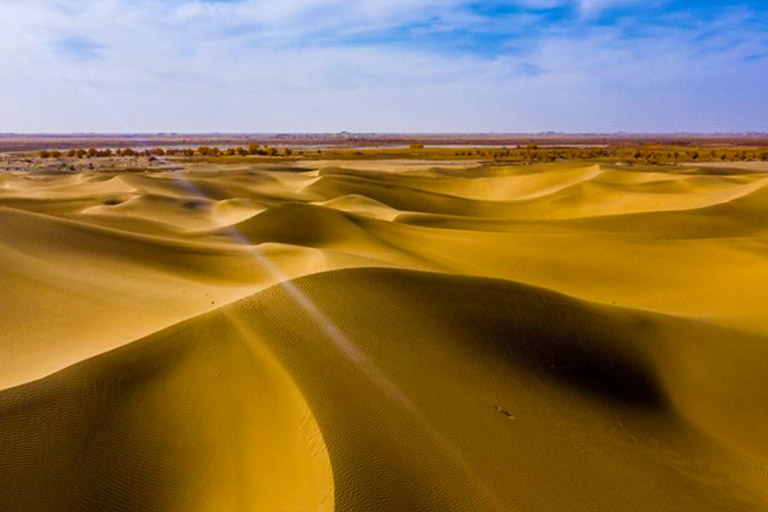
Taklamakan Desert Scenery ©托尼star / mafengwo
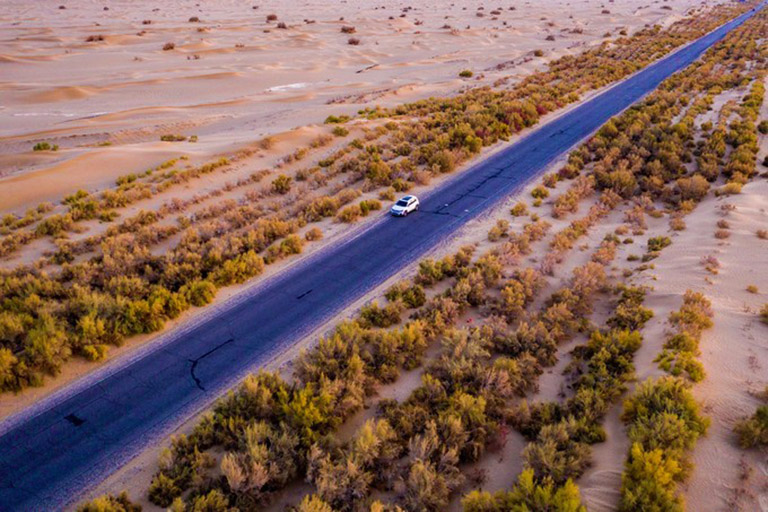
Taklamakan Desert Highway ©CrazyWolfkin / mafengwo
• Location: Tarim Basin, Xinjiang
• Best Time to Visit: Late October ~ Mid-November
• Recommended Visiting Time: 2 hours
Taklamakan (also spelled Taklimakan) refers to “can get in, can’t get out” in Uyghur. The Taklimakan Desert in central Tarim Basin, southern Xinjiang is the largest desert in China and one of the five most beautiful deserts, and the world’s 10th largest desert and the second-largest drifting desert. The desert expands 1,000 km from east to west, 400 km from north to south with a total area of 330,000 square kilometers. Taklamakan Desert is mainly located in four regions of Southern Xinjiang: Kashgar, Hotan, Aksu and Bayingolin Mongol Autonomous Prefecture.
The dry climate with little rainfall and frequently changable sand dunes make it difficult and dangerous to explore and venture deep into the Taklamakan Desert. However, great country China has built several highways through the hinterlands of Taklamakan Desert, which provide visitors to catch a glimpse of this mysterious desert. The most popular desert highways include the Tarim Desert Highway (Luntai-Mingfeng) and Hotan-Ala’er Desert Highway. When sitting in the car, you can see infinite sand dunes of different shapes by the road. Some sands are plain, some like pyramids, hills, dragons, feathers, fish scales, and change quickly. Looking out of the window, you definitely feel you and the car are so small, just like a boat in the sea. When driving between Luntai and Minfeng, the golden populus euphratica forests around Luntai are so attractive and incredible. You will be deeply shocked by its beauty and strong vitality in awe. Travelling with a profession and experienced travel agency is the best way to make a Taklamakan desert trip, both for safety and better travel experience.
Recommended Taklamakan Desert Tours:
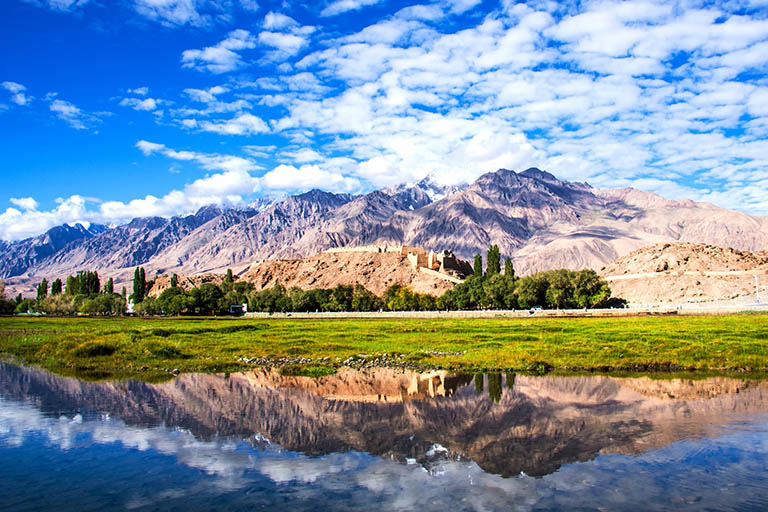
Tashkurgan Stone City ©陈巍伟 / mafengwo
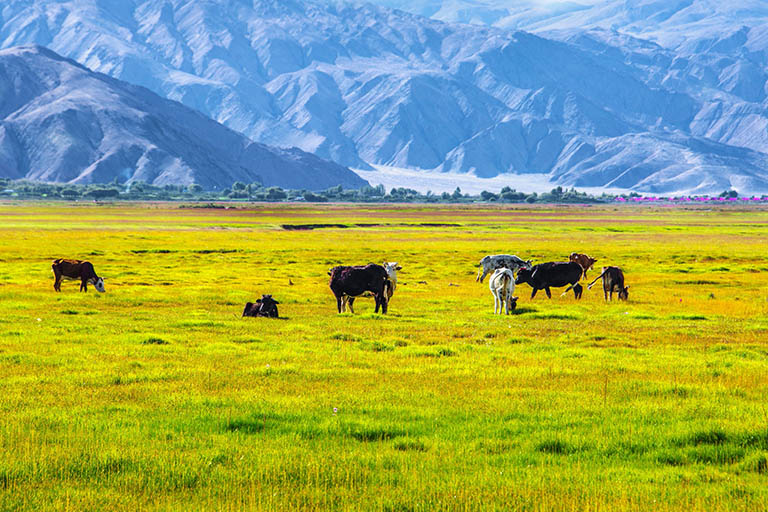
Tashkurgan Alaer Golden Grassland ©陈巍伟 / mafengwo
• Location: Tashkurgan Tajik Autonomous County, Kashgar, Xinjiang
• Best Time to Visit: July & August
• Recommended Visiting Time: 1 ~ 2 days
Tashkurgan stands for “Stone City” in the Uygur language. Tashkurgan County is named after the ancient stone fort, the most-known ruins of ancient city in the north of Tashkurgan County. In the Han Dynasty (202 BC-220 BC), the “Stone City”, officially Tashkurgan Fort, once was the palace of Puli Kingdom. The middle and south routes of ancient Silk Road met here. The fort was also the must pass to Pamirs Plateau for travelers from Kashgar, Shache (Yarkand), Yecheng and Yingjisa. But when the Qing Dyanty built a new town in the south, the stone city was gradually abandoned and damaged.
The ruins of Tashkurgan Stone City is one of the three ancient greatest stone cities in China. Constructed on high hills with a squircle shape, Stone City worked as a natural barrier. Now you can still see many broken city walls in outer areas and some ruins of barbettes and ancient houses. Lots of rubbles are scattered inside. Some old coins and books have been excavated here. The stone city itself is a great ancient project for both historical and cultural research. The epibiotic historical part, together with sublime snow-covered mountains behind and huge Alaer Golden Grassland beneath, make Tashkurgan Stone City a special sight on Pamirs.
Recommended Kashgar Tashkurgan Tours:
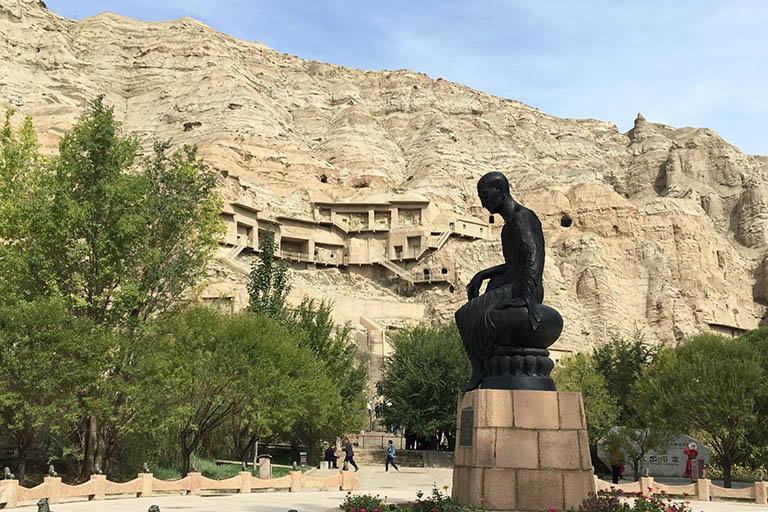
Kizil Caves ©小羊湄 / mafengwo
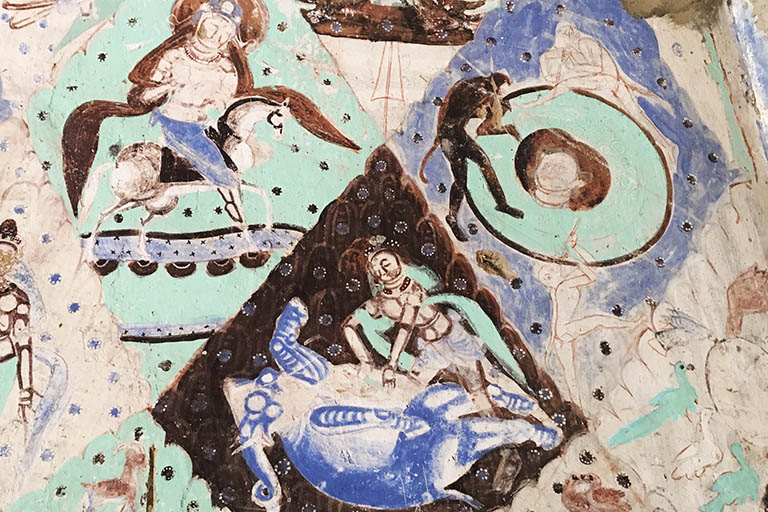
Cave No.17 of Kizil Caves ©瑜乐 / mafengwo
• Location: Baicheng County, Aksu Prefecture, Xinjiang
• Best Time to Visit: May ~ June, September ~ October
• Recommended Visiting Time: 2 hours
Carved on a riverside cliff of Baicheng County, Kizil Caves (or Kizil Grottoes, Kizil Caves of Thousand Buddhas) is an UNESCO World Cultural Heritage site on the ancient Silk Road. The caves were excavated about the 3rd century, nearly 300 years earlier than Dunhuang Mogao Caves and took hundreds of years to finish its completion. It is the oldest and westernmost Buddhist grottoes in China.
Kucha (Kuqa) County and surrounding areas were the ancient Qiuci Kingdom (176 BC ~1001 AD). After Buddhism came into Xinjiang via the silk Road during the Eastern Han Dynasty, it received attention and worship from the Qiuci Kingdom. In the 4th century, the kingdom built many grand Buddhist temples and started excavation of Kizil Caves which lasted until the Tang Dynasty. The remaining Kizil Caves has 339 caves including 236 numbered distributed in four different grottoes areas. Most Buddhist sculptures have been completely destroyed and stolen, only 81 caves preserve some incomplete murals. Only several caves are open to tourists.
Accompanied by a tour guide, you can visit the caves one by one with a detailed explanation. Beyond the long history, Kizil Caves is characterized by the special design of “Central Pillar” cave structure combining main shrine, monk house and other different zones, perfect fusion of Chinese and exotic cultures and arts and rich content of the Buddhist world and scenes of ancient lifestyle. The murals are fragmentary but the contents and style are very unique, such as the male flying Apsaras, large use of diamond story paintings and rarely seen but never-fading blue pigment. After visiting the caves, you will learn a little about Buddhism in China, remarkable ancient wisdom and art and culture and the history of the Qingci Kingdom.
Recommended Kizil Caves Tours:
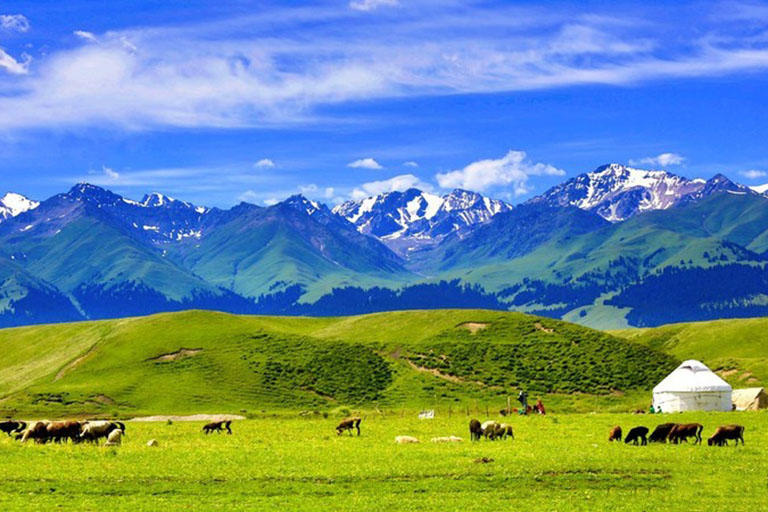
Naraty Grassland ©mafengwo
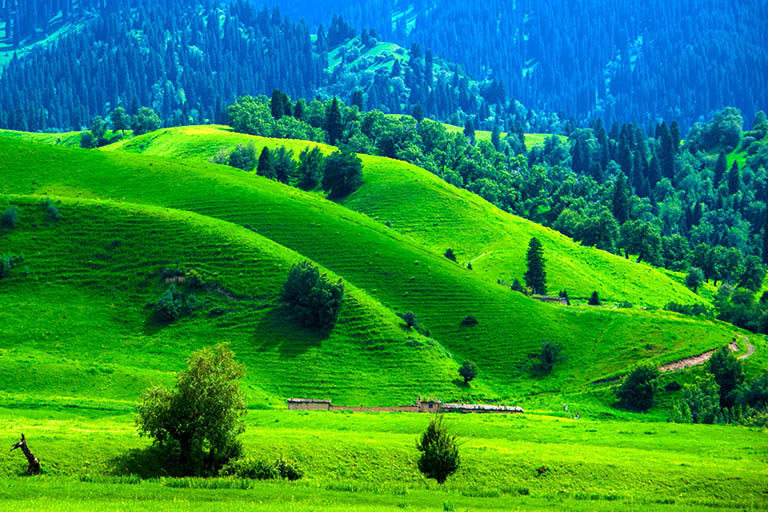
Naraty Grassland ©陈巍伟 / mafengwo
• Location: Xinyuan County, Ili Kazakh Autonomous Prefecture, Xinjiang
• Best Time to Visit: June ~ September
• Recommended Visiting Time: 1 ~ 2 days
Naraty Grassland or Nalati Grassland in deep Tianshan Mountains, east of Ili River Valley, is another very beautiful and famous grassland in Ili, which is most known as A Grassland in the Sky in Xinjiang. It is one of the world’s four grasslands of subalpine meadow. More than vast grassland, Naraty Grassland owns exclusive scenery of snowy mountains, meadows, rivers, valleys, forests, waterfalls, a long history and strong ethnic culture. Every June to September, the grass in the area will become lush and green. In the meantime, various kinds of wild flowers will be in full blossom. Naraty Grassland in this period is attractive and stunning. Your mind will be blown away and you surely want to settle down here when the fairyland-like Naraty Grassland unfolds before your eyes. Sky Grassland is the main part to visit, because you can view pink Apple flowers, countless mountains, plain and curvy grassland landscape, dense green woods and white Kazak yurts. Scenic areas like River Valley Grassland, Panlong Valley have remarkable scenery as well.
Kazak people have lived in Naraty Grassland since the Western Han Dynasty and still kept their original nomadic lifestyle. After September, Naraty Grassland will put on a yellow coat, where groups of sheep and horses will be transferred to other grasslands at lower elevation. Besides, many Kazak nomads will host local festivals, and you may experience horse riding, visit a local family and authentic ethnic culture and tradition with luck.
Recommended Naraty Grassland Tour: 10 Days Stunning Ili Apricot Blossom and Naraty Grassland Tour
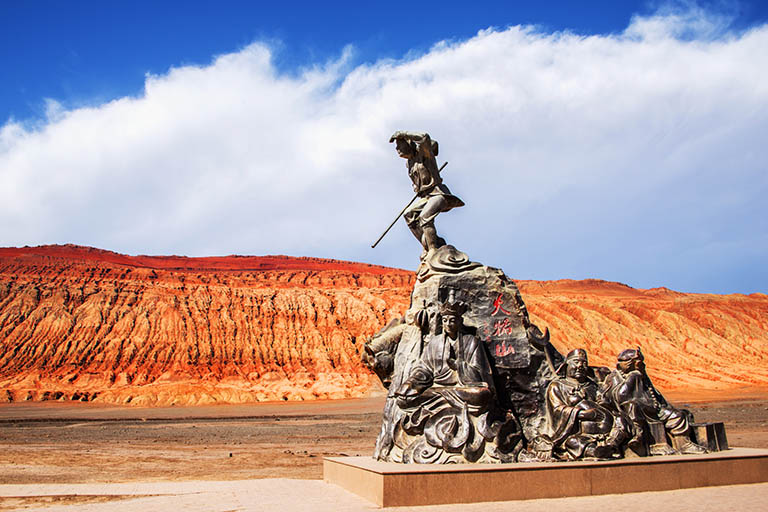
Turpan Flaming Mountain ©陈巍伟 / mafengwo
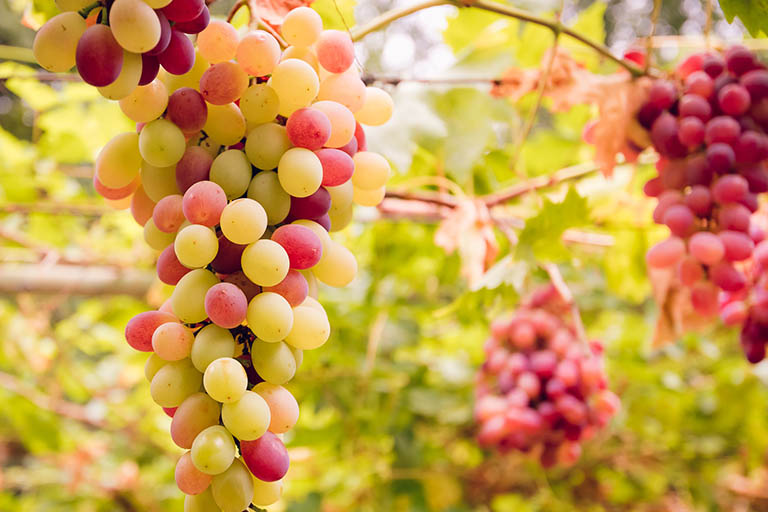
Grapes in Turpan Grape Valley ©文刀四火 / mafengwo
• Location: Gaochang District, Turpan City, Xinjiang
• Best Time to Visit: May ~ October
• Recommended Visiting Time: Half a day
Turpan in Uygur means the lowest place and the city is the location of ancient Gaochang Kingdom. Flaming Mountain (Mountain of Fire) is the most famous tourist attraction in Turpan. It is located on the north edge of Turpan Basin and on the north route of Silk Road, extending with a length of 100 km and width of 100 km. Because the mountain body is formed by red stones, conglomerate and mudstones of Mesozoic Jurassic, Cretaceous and Tertiary, Flaming Mountain is called red mountain by local people. In Journey to the West (Xiyouji, one of the four greatest classical novels of Chinese literature), Monk Tang Sanzang and his three apprentices were blocked by this fire mountain and many stories hence happened here, which make the spot known to the public.
Flaming Mountain is most famous not for its height but for its high temperature, special fire-like colors and unusual landform. It is said that the highest temperature of Flaming Mountain can rise to 47.8°C in summer and the maximum surface temperature is nearly 90°C. Eggs can be roasted soon here. No plants grow on the mountain, nor animals live there. After a sightseeing trip to Flaming Mountain Grand Canyon to see the special red mountains, you can spend more time exploring Bezeklik Thousand Buddhist Caves and Gaochang Ancient City, visiting Mazar Village in Tuyuk Valley with special dwellings and tasting sweet and juicy grapes in Grape Valley.
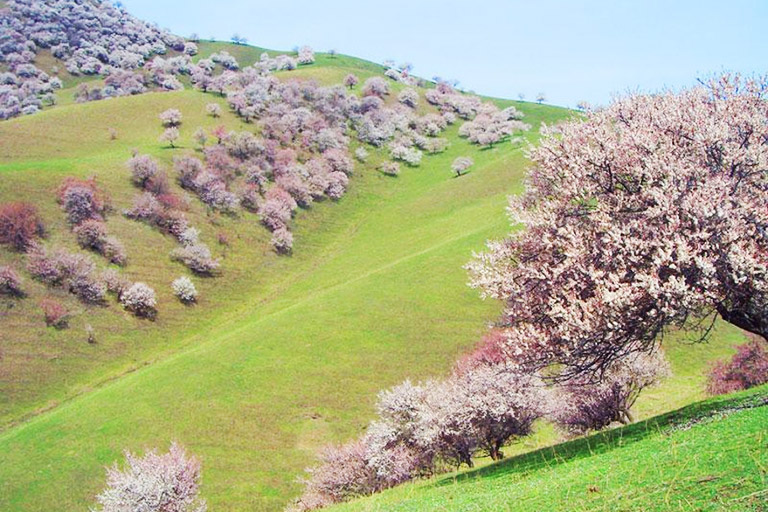
Ili Apricot Blossom in Spring ©mengjie / qunar
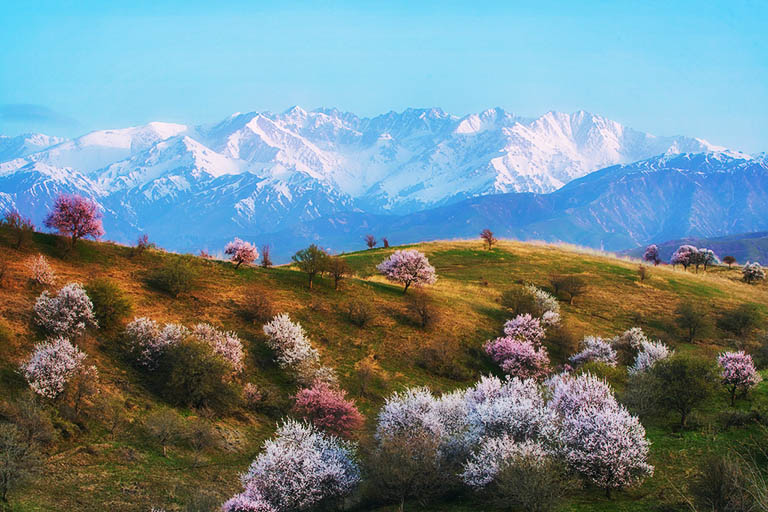
Ili Apricot Blossom in Spring ©小骆驼 / qunar
• Location: Xinyuan County, Ili Kazakh Autonomous Prefecture, Xinjiang
• Best Time to Visit: Late March ~ Early May
• Recommended Visiting Time: 1 ~ 2 days
When it comes to the most beautiful spring scenery in Xinjiang and all across China, Ili’s Apricot Valley will always win a place. Every April, when the Apricot flowers are in full bloom, nature lovers and enthusiastic photographers flood into Ili to appreciate the beautiful blossom and natural scenery.
The valley is dotted with Apricot trees, which are said to be grown from the 14th century. The Apricot Valley of Ili occupies about 30,000 acres with the largest number of wild apricots in Xinjiang. From late April, the pink wild Apricot blossom, verdant mountain meadows with gorgeous curves, featured ethnic houses and lazily grazing herds, imposing Narati Snow Mountain and flowing Gonggaisi River draw an ideal pastoral beyond description. Be aware that the florescence of Ili Apricot blossoms is very short and this place is a hot destination during late spring, please plan your itinerary properly in advance.
Recommended Ili Apricot Valley Tours: 10 Days Stunning Ili Apricot Blossom and Naraty Grassland Tour
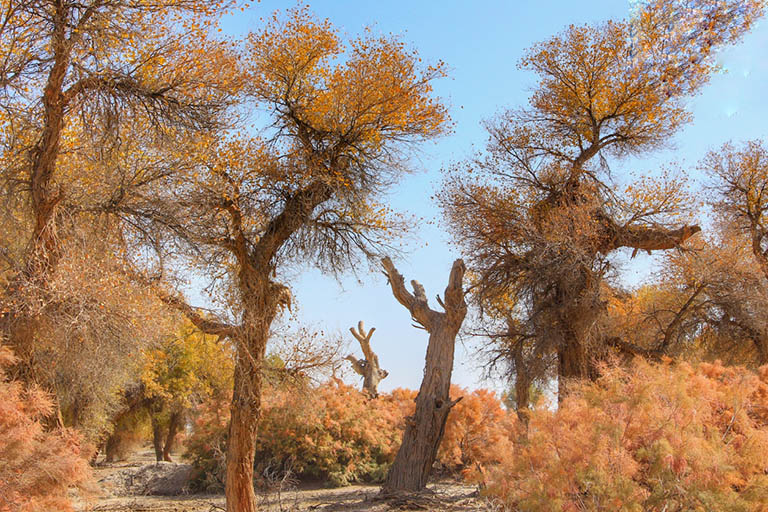
Tarim Populus Euphratica Forest in Autumn ©十二月立夏 / mafengwo
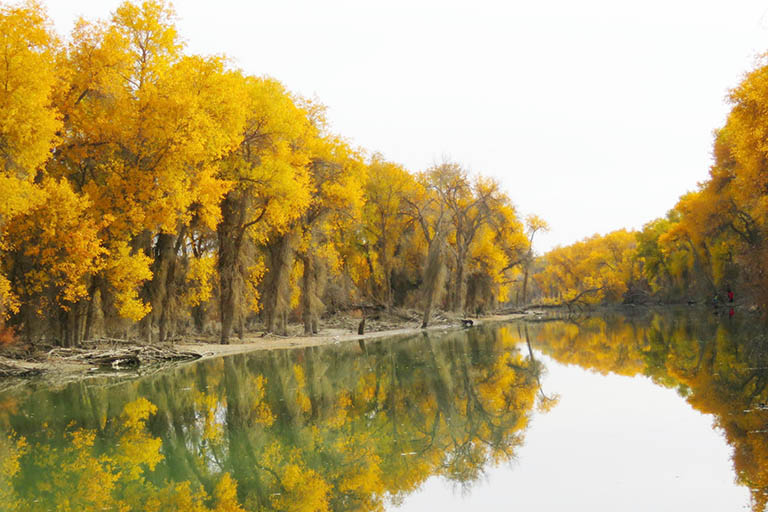
Tarim Populus Euphratica Forest in Autumn ©启陵巴洛 / mafengwo
• Location: Luntai County, Bayinggolin Mongol Autonomous Prefecture, Xinjiang
• Best Time to Visit: Late October ~ Early November
• Recommended Visiting Time: Half a day
Almost all people think deserts are barren and forbidden zones of life. Populus Euphratica Forest reverses that impression and proves its tenacious vitality. Do you know that most Populus Euphratica Forests in the world are located in China? And in China, most are in the desert and gobis in Xinjiang (around 90% of total numbers), Gansu and Western Inner Mongolia. In Xinjiang, they are concentrated around the Tarim Basin and Taklamakan Desert.
The Euphrates Poplar is one of the oldest, most precious and mysterious trees in Xinjiang and the only natural long-living survivor in the wild deserts. Tarim Populus Euphratica Forest in Luntai, Bayingolin Mongol Autonomous Prefecture is the most beautiful and famous. In this national forest park, visitors can view wide-spread Populus Euphratica Forests with relatively good growth conditions. The landscape is very amazing when desert, river, lake and Populus Euphratica Forest appear simultaneously. The more interesting part is the trees growing in different postures, full of artistic beauty, some like a human being, animal, etc. Autumn is the best time to visit the Tarim Populus Euphratica Forest, because all the leaves will turn golden yellow, decorating the desert and riverbank a real fairyland. Mulei Populus Euphratica Forest in Changji, Northern Xinjiang is also famous for it has the oldest Euphrates Poplar in the world with a striking history of 65,000,000 years. (Top 8 Populus Euphratica Forests in China)
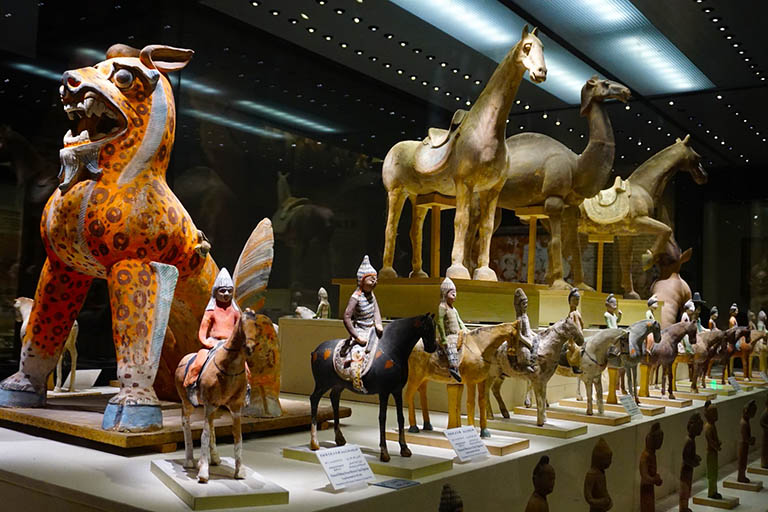
Xinjiang Regional Museum Cultural Relics ©川玖 / mafengwo
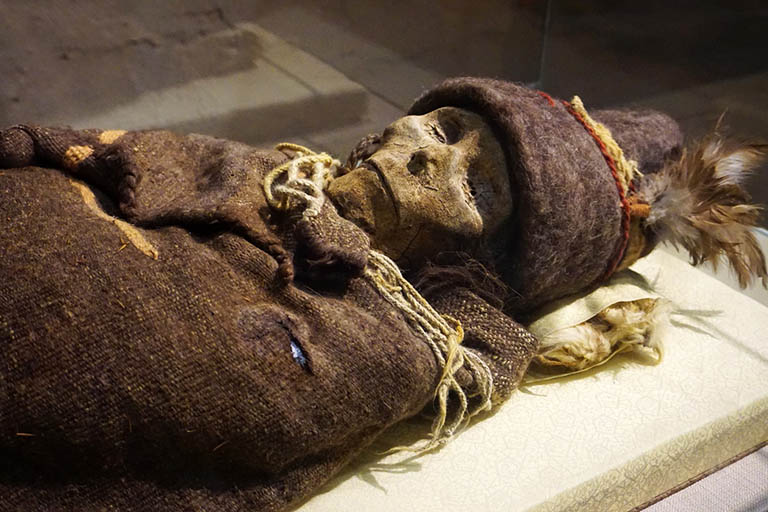
Xinjiang Regional Museum Cultural Relics ©川玖 / mafengwo
• Location: Urumqi City, Xinjiang
• Best Time to Visit: All year round
• Recommended Visiting Time: 1 ~ 2 hours
Xinjiang Regional Museum, located in downtown Urumqi, is a provincial comprehensive museum and one of the must-visit museums in Xinjiang. The new Xinjiang Regional Museum building is decorated with Xinjiang minority elements and displays many significant artifacts and cultural relics discovered in Astana Tomb, Niya Ruins and different sites of Xinjiang. So, the museum is a good place to know about the history and ethnic culture of Xinjiang. The starting exhibition - Memory on the History of the Western Regions tells the glorious past of Xinjiang and has treasures like invaluable Paintings of Fuxi and Nywa, wooden figures of Tang Dynaty, traditional brocade, etc. Another focus and highlight of Xinjiang Regional Museum is the Mummy Exhibition, which collects several ancient mummies found in Xinjiang, including the noted “Loulan Beauty”. The exhibition might be scary, but it can help people understand the ancient funeral culture. In Display of Xinjiang Nationality Customs, lifelike statues and life scenes give visitors a clear and special way to learn the ethnic groups' costumes, living, festival celebration, dining, religion, etc.
Recommended Urumqi Tours with Xinjiang Regional Museum:
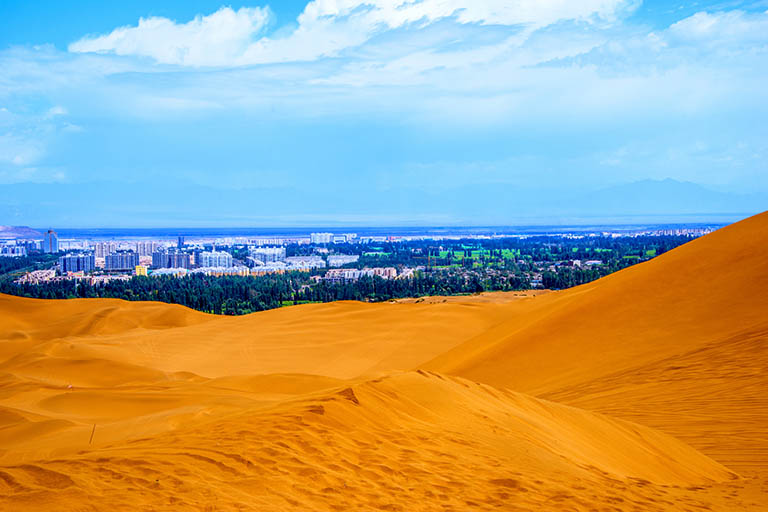
Turpan Kumtag Desert ©陈巍伟 / mafengwo
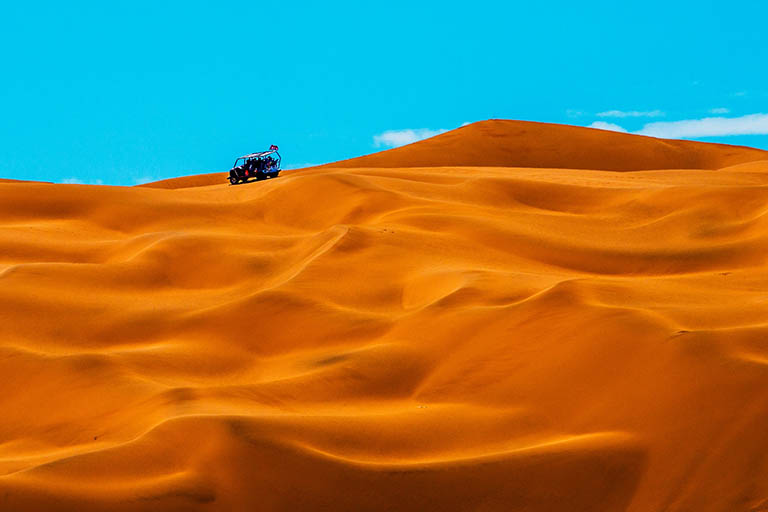
Turpan Kumtag Desert ©陈巍伟 / mafengwo
• Location: Shanshan County, Turpan City, Xinjiang
• Best Time to Visit: June ~ August
• Recommended Visiting Time: Half a day at least
Kumtag Desert in Turpan’s Shanshan County is Xinjiang’s third-largest desert and the fifth-largest desert in China. It’s a drifting desert located just 90 km, 1.5 hours’ drive from Turpan City. Kumtag Desert has three attractions appealing to visitors. One is that the desert is where the Loulan Kingdom disappeared mysteriously. Being the desert closest to the city in the world is the second surprise. It has formed for thousands of years, but never invaded the city nearby. When you see the miracle where modern city live in harmony with the wild desert, you will be shocked. The last and the main attraction is magnificent desert landscape and various kinds of entertainment. The sands here are much smaller than that of the Taklamankan Desert. You can enjoy amazing sand dunes and playing sands, having thrilling desert Jeep safari, camel riding, sand sliding, motorcycling, camping, campfire parties and watching night shows. If you plan to stay longer, don’t miss the sunset and sunrise.
Recommended Turpan Tour with Kumtag Desert: 3 Days Turpan Highlights Tour with Kumtag Desert
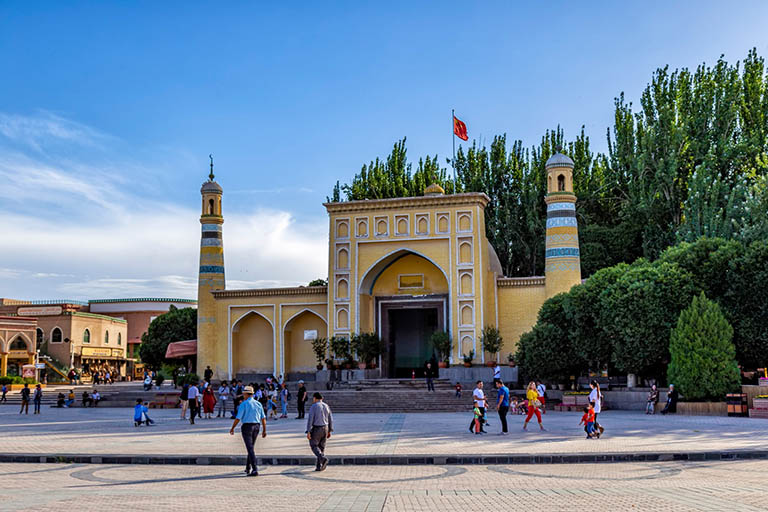
Id Kah Mosque ©托尼star / mafengwo
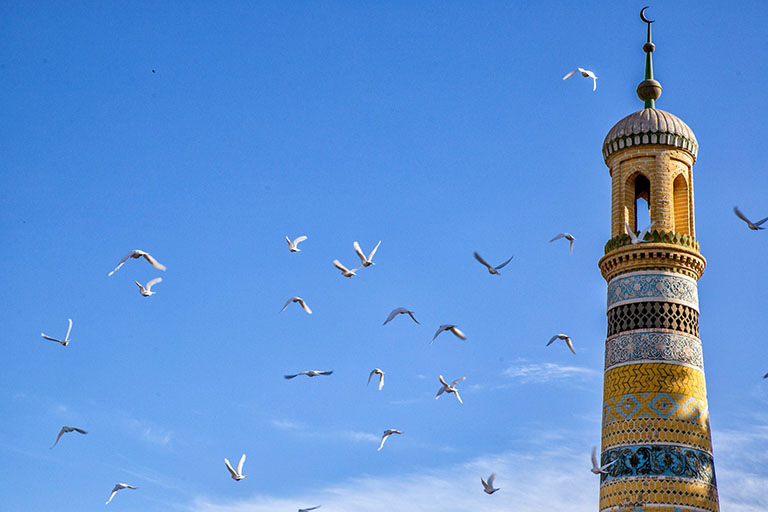
Id Kah Mosque ©托尼star / mafengwo
• Location: Kashgar City, Kashgar Prefecture, Xinjiang
• Best Time to Visit: April ~ October
• Recommended Visiting Time: 1 hour
A mosque is where Muslims gather and worship. Xinjiang has more than 22,000 mosques in total, so it’s common to see different mosques all over Xinjiang. Id Kah Mosque, located in central Kashagr City, is the biggest mosque in Xinjiang and China and one of the landmarks of Kashgar. The mosque complex was originally built in 1442 and got many expansions and reconstructions. It presents strong ethnic style and Islamic culture and is honored as one of the finest Uygur architectures. In history, the Id Kah Mosque used to be a school whic taught Islamic culture. Many scholars and honored clergies graduated from here.
Outside the mosque is the huge Id Kah Square, where many Uygur children and old men like to spend leisure time here. The front entrance with elegant beautiful gates and towers attracts many visitors to take photos. The interior is a courtyard consisting of lecture halls, and a main prayer hall. You will be impressed by the colorful pillars in the corridor and prayer carpets outside and inside the prayer hall, because they’re so fresh, artistic and beautiful. Every day, there are thousands of Muslims worshiping here. Every Friday (Jummah) and grand festivals like Eid ul-Fitr (End of Ramadan), Eid ul-Adha, there is a staggering amount of worshippers assemble in the mosque and make grand prayers. So, when in Kashgar, visiting Id Kah Mosque helps you enjoy Islamic religious culture and art.
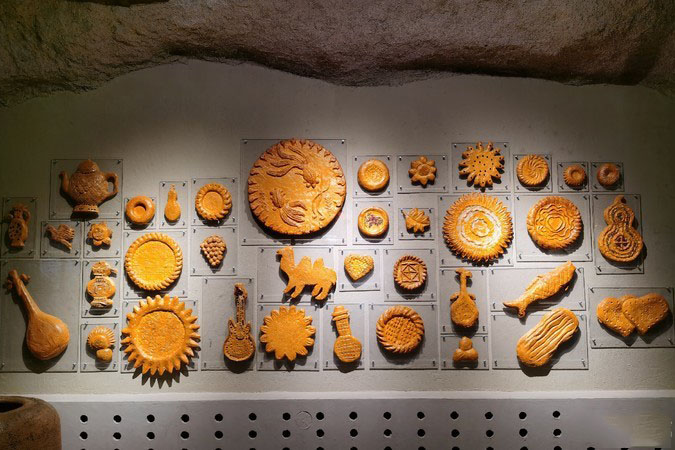
Urumqi Nang Museum ©mafengwo
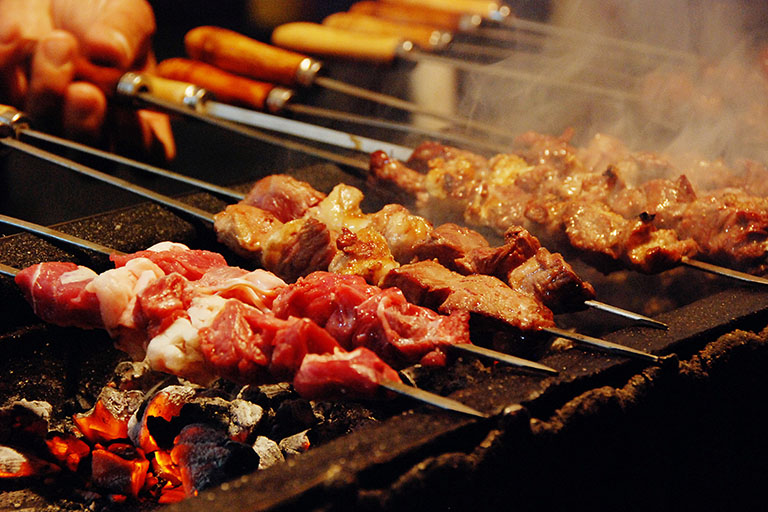
Mutton Shashlik in Kashgar Night Market ©kido / mafengwo
• Where to Eat: Bazzars, Foods Streets, Urumqi, Turpan, Kashgar... in Xinjiang
As Xinjiang is a multi-ethnic region in northwest China, it has a surprisingly rich and unique food culture. Each minority group, each destination, has their own flavor. Beef and mutton are the main diets. When visiting Xinjiang, it’s quite interesting and meaningful to try some local food and snacks to learn about their dining culture. Bazaars and food streets around the main tourist cities are the best places to hunt for delicious snacks. Xinjiang cuisine is served in a big portion, and if you have special requirements, just tell the tour guide to arrange suitable meals for you. The top recommended main Xinjiang courses include Dapanji, boiled mutton, roasted mutton shashlik and spiced chicken with chili sauce. Other popular snacks in Xinjiang are Nang, hand pilaf, noodles (sauced, fried, ), baked samosa, fried rice-flour noodles, etc. In Urumqi, Kashgar, Turpan and other major destinations, you can find restaurants providing Sichuan Cuisine and other cuisines you can choose from. Xinjiang is called “a land of melons and fruits” for its diversity of luscious fruits too. Their prices are cheap for tourists. Here comes the list for you to enjoy sweet and juicy seasonal fruits: grape and watermelon (Turpan), melon (Hami), apricot (Ili), pearl (Korla), apple (Aksu), pomegranate (Yecheng), etc.
Recommended Xinjiang Tours:
Xinjiang is too vast to finish exploration just in one go. If you’re planning a longer trip or a few times travel to Xinjiang, there are many other points of interest you can visit, like Dushanzi Grand Canyon, Jiangjunshan Ski Resort for winter skiing and so on. China Discovery is an experienced, professional and reliable travel agenct who dedicates ourselves to offering high-quality and worry-free private tour packages for our customer. Whether you want to have a sightseeing tour, or a Silk Road cultural exploration, a photography tour, a hiking, a family tour, we can always help you plan a wonderful itinerary. The best experience and high price ratio are both guaranteed. The right is other Xinjiang travel inspirations. You can select from the following most popular Xinjiang tour packages or contact us to customize a once-in-a-lifetime journey for you.
Start planning your tailor-made holiday to China by contacting one of our specialists. Once inquired, you’ll get a response within 0.5~23.5 hours.
Customize a Trip